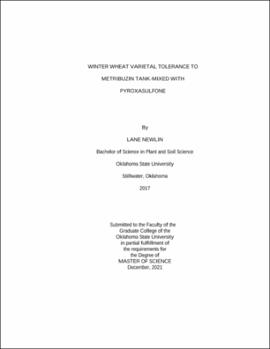| dc.description.abstract | Metribuzin is a herbicide that is widely used in cropping systems. However, its use in winter wheat in Oklahoma has declined due to varietal sensitivity or lack of information regarding the topic. To evaluate modern wheat varieties, a trial was conducted at Dacoma, Fort Cobb, Goodwell, and Perkins, Oklahoma during the 2019-2020 growing season and Fort Cobb, Goodwell, and Perkins during the 2020-2021 growing season. Varieties LCS Fusion AX, Showdown, Strad CL Plus, and Uncharted were evaluated. Treatments consisted of two herbicide tank mixtures (pyroxasulfone at 119 g ai ha-1 plus 105 (1X) or 210 (2X) g ai ha-1 of metribuzin) and a nontreated control. Mixtures were applied preemergence (PRE) or delayed preemergence (DPRE). Peak visual crop injury and crop yield were recorded. For peak visual injury, there was an application timing by metribuzin rate interaction at Fort Cobb and Perkins in 2020 and Fort Cobb and Goodwell in 2021 where the 1X rate of metribuzin applied DPRE resulted in similar or less damage than the same rate applied PRE. Meanwhile, the 2X rate always resulted in the greatest injury compared to the 1X rate and nontreated. In 2020, applying the 2X rate PRE resulted in the most crop injury at Perkins while Fort Cobb injury was similar for PRE and DPRE applications at the 2X rate. At Fort Cobb and Goodwell in 2021, the highest crop response was recorded following the 2X rate applied DPRE. For grain yield, a variety by rate interaction at in 2020 revealed that Showdown was the only variety with no yield reduction at 1X and 2X rates compared to the nontreated. For the same interaction at Fort Cobb, yield decreased for all varieties each time herbicide rate increased. A variety by application timing interaction was recorded at Dacoma in 2020 and at Fort Cobb in 2021. At Dacoma, yield was reduced for LCS Fusion AX at the DPRE timing compared to the PRE. At Fort Cobb, the same trend was observed for all four varieties. Results suggest that variety, soil type, application timing, metribuzin rate, and environment play an important role in crop response. | |
